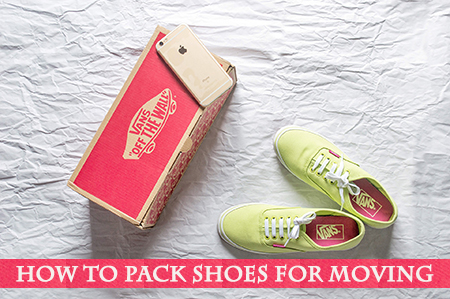 When packing for a move, sooner or later you’ll get to packing your footwear as well. And when that happens, you may get tempted to just throw all your shoes into a large box and be done with it.
When packing for a move, sooner or later you’ll get to packing your footwear as well. And when that happens, you may get tempted to just throw all your shoes into a large box and be done with it.
The thing is that you shouldn’t do it. Resist such temptation because improper packing of shoes can easily damage your pairs in various ways: scuffing, misshaping, and so on. Show some respect to your footwear and pack your shoes properly when moving house.
Although packing shoes for a move may seem easy enough and pretty straightforward, there are still a few important shoes packing tips to remember to keep your footwear in good condition throughout the move. Be mindful that untimely damage to your footgear can mean that you may have to buy new shoes after you’ve moved into the new home – a highly unnecessary post-relocation expense that you won’t be too thrilled to make.
The good news is that you won’t lose much time wrapping up and protecting your footwear for the move, especially when you know the best way to pack shoes for moving.
How to prepare your shoes for packing: 5 shoe preparation steps
Before we move on to describe the best way to pack shoes for moving, let’s go through the initial 5-step preparation stage that will ensure your shoes and boots are ready to be protected and boxed for the upcoming move. Provided that you value and care about the shoe pairs that you own, so you do NOT want to skip these steps.
1. Sort out your shoes
You don’t want to pack and move all pairs of shoes you have without sorting them out first because 1) you don’t wish to lose time packing things you won’t use again and 2) you don’t want to pay for the transportation of things you’ve never liked anyway.
- Your task is to sort all the shoes you own and encourage each family member to do so with their respective shoe pairs as well.
- Go through each shoe pair and decide whether you wish to keep it, sell it, or donate it. That’s right – the approaching house move is the ideal moment to finally slim down your shoe collection.
-
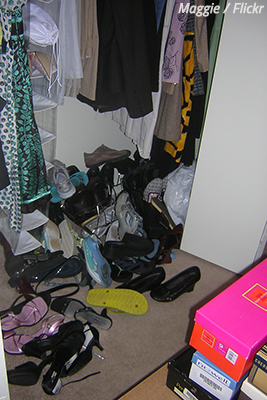
Don’t make the rookie mistake of packing and moving your shoes without sorting them out first.
Set aside the shoes that are already too worn out or damaged to continue to be of any use – they should go directly into the recycling bin.
- Set aside the shoes that are still in good condition but which you never liked for some reason or another – too uncomfortable, too outdated, too formal, etc. Such pairs of shoes should be either sold or donated.
- Sort the remaining shoes – the ones you’re taking with you – according to season and your specific needs. For example, set aside all winter boots for pre-packing if you’re moving in the summer, and vice versa.
- Group all shoes you’re about to pack according to their type – boots, sneakers, and sports shoes, formal shoes, high-heels, slippers, flip-flops, and so on.
- Set aside any shoes that you’re taking with you but need to be repaired to be worn again. If you happen to have enough time, have them fixed prior to the move simply because you already know where the location of the best shoe repair services in town.
- Set aside for packing all shoes that you know you won’t need prior to your move-out day.
2. Select the pair of shoes you’ll be wearing on Moving day
Don’t forget to choose the pair of shoes that you will wear on the day of the move – after all, you don’t plan to pack up all the shoes you own and remain bare-footed during the most dangerous day of the house move.
- Select your most comfortable pair of shoes.
- Opt for closed shoes with good traction and anti-slip soles.
- Choose a pair of sports shoes with sufficient ankle support.
3. Clean and dry out your shoes
Find time to clean the pairs of shoes you’ve decided to move to the new home. It’s not good for them to remain dirty during the move, and besides, when you do the cleaning bit before the move, you won’t need to have to deal with that after the move, so you’re not going to actually lose any time. Remove the dirt and dust with a soft damp cloth and be extra careful when cleaning the more expensive and delicate footwear you own.
Also, it’s important that you let your shoes dry out completely before packing them up. This is so because any moisture that gets trapped inside them may cause mold to grow – an unfortunate occurrence that can damage those pairs forever. Sports shoes, work shoes, and leather shoes are especially at risk if packed wet or when not fully dry. So, let your footwear air dry for a few hours before you start packing shoes for moving.
4. Stuff crumpled paper into your shoes
Before you learn how to pack shoes properly, you’re going to have to stuff crumpled paper in them to get them to keep their shape during the move. You want to pack shoes without crushing them, so take one sheet of clean and soft packing paper, crumple it well into an oval shape and stuff it inside each shoe. When packing boots for moving, stuff them with paper all the way to the top.
In any case, do NOT use newspapers for stuffing up your shoes because the ink may transfer into their material and ruin them. Using socks to keep the shape of your footwear will also work ok in most cases, but your safest choice is still packing paper as it is stiffer and harder to bend.
5. Gather the proper shoe packing materials
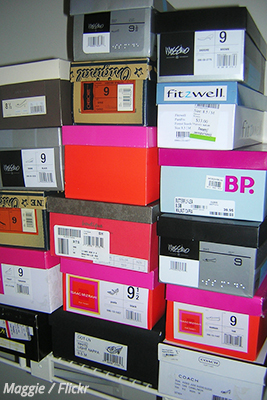
The best way to pack shoes for moving is to use the original shoe boxes your footwear came in.
Finally, before you reach the actual tips for packing shoes when moving, let’s say a few words about the packing supplies you will need to get the job done.
The proper shoes packing materials are as follows:
- Small or medium boxes
- Original shoe boxes if you still keep them
- Packing paper
- Bubble wrap
- A permanent marker
That’s it – that’s all you’ll need to protect your footgear for the relocation journey.
Important: DO NOT pack your treasured shoes into plastic bags because they will most likely trap moisture that way and grow mold. Instead, stick to soft packing paper and cardboard boxes as described below.
Now that you’ve completed the preparation phase of the shoe packing task, it’s time to learn how to pack your shoes for moving using 2 similar yet different packing methods: packing shoes in shoe boxes and packing shoes without their original shoe boxes.
How to pack shoes in shoe boxes: Step-by-step
Naturally, the best way to pack shoes for a move is to do so in their respective shoe boxes. The reason is simple enough: an original shoe box is designed to fit perfectly the exact size and shape of the pair of shoes it holds, thus eliminating any chance of damage due to shifting of the footwear inside the box.
Here are the steps to the easiest way to pack shoes when moving from one home to another:
- Step 1. Place one large sheet of paper on the bottom of the shoe box.
- Step 2. Position the thick stack of clean packing paper on your work area.
- Step 3. Place one shoe in the corner of the top sheet and start wrapping it, rolling it down the entire diagonal length of the paper sheet.
- Step 4. Tuck the overlapping paper edges as you’re wrapping the shoe in paper until a neat bundle is formed.
- Step 5. Use a piece of tape to fix the bundle in place when you’ve covered the shoe completely.
- Step 6. Transfer the wrapped shoe into the shoe box.
- Step 7. Pack the other shoe in exactly the same way.
- Step 8. Transfer the second shoe in the same box to complete the pair. Position the second piece facing the other one but alternate their directions to make your shoes fit inside the box without you having to add extra pressure.
- Step 9. Cover the wrapped shoes with the bottom paper layer for extra protection, then close the top box cover and fix it in place using small pieces of tape.
- Step 10. Finally, label the shoe box using the permanent marker.
What to pack first when moving
How to pack shoes without shoe boxes: Step-by-step
If you don’t happen to keep the original shoe boxes of your pairs of shoes – by far the more common scenario, then you’re going to have to pack your shoes for a move inside a medium-size cardboard box. That shoe packing method, described in detail below, is often referred to as the shoe burrito.
Here are the steps to the best way to pack shoes without their shoe boxes.
-
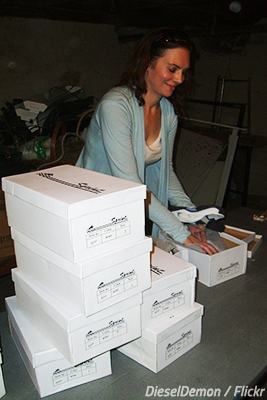
It looks like our tips for packing shoes for moving are working great.
Step 1. Place a sheet of paper on the bottom of the cardboard box.
- Step 2. Position a large sheet of clean packing paper on your packing station or work area – usually a table or another flat surface in the home.
- Step 3. Place one of the shoes in the corner of the paper stack and roll it about halfway, covering it entirely with part of the paper sheet.
- Step 4. Add the other shoe to the first one, opposite and fitting into it, before you have used the rest of the paper sheet.
- Step 5. Continue to roll the paired shoes into the rest of the paper sheet, tucking the overlapping paper edges until a neat and tight bundle is formed.
- Step 6. Use pieces of tape to secure the shoe bundle and keep it from unwrapping inside the box.
- Step 7. Transfer the packed pair of shoes into the box, and position them flat.
- Step 8. Repeat these packing steps for all your shoes, starting off with the heaviest pairs and ending with the lightest pieces of footwear. The reason to employ this safety rule is that lighter shoes might get crushed under the weight of the heavier ones.
- Step 9. Fill in the bottom row, then start your next row by placing a clean sheet of paper to separate the next layer of shoes.
- Step 10. Fill the cardboard box to the top without overfilling it. If there’s any space left in the box, use crushed paper to fill it up so that the shoes don’t shift during transport.
- Step 11. Do not place any heavy items on the top of the shoes that have already been packed and arranged in the box.
- Step 12. Place one clean sheet of paper on the very top, close the lids of the carton and tape it shut.
- Step 13. Label the box (SHOES) using a permanent marker.
How to pack for a move like a pro
Safety tips for packing shoes when moving
As you can see, packing shoes for shipping is not complicated in any way – you only need to follow some basic packing steps and your footwear will stay protected no matter the relocation distance.
To wrap it up, here are the most important SAFETY tips for packing shoes for moving to guarantee yourself a damage-free shoe packing and moving experience.
-
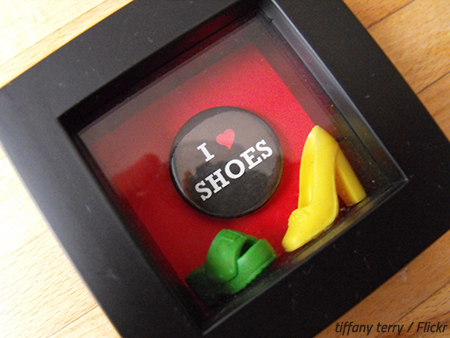
If you really love your shoes, then you will follow our shoe packing advice.
Say NO! to plastic bags. As mentioned above, don’t use plastic bags for packing your shoes when moving house. Plastic bags get easily torn and they tend to trap moisture, which in turn will most likely damage your valuable footwear. Instead, always use clean packing paper.
- Say YES! to paper stuffing your shoes. As explained above, you should always stuff your shoes with clean and soft packing paper prior to packing them to preserve their shape and prevent possible deformations on the road.
- Pack the heavy shoes first. Heavier shoes should always go to the bottom of a medium sized cardboard box, with the lighter footwear on top of them. If you do it the other way round, you run the risk of crushing some of the more delicate shoe pairs.
- Do not overload or overfill the boxes. It’s not advisable to overload or overfill the boxes – both packing scenarios could lead to some type of damage to your shoes. Instead of trying to stuff all your pairs into a single large box, distribute them into several smaller boxes to keep things as safe as they can be.
- Say YES! to bubble wrap. Besides packing paper, bubble wrap can be used to keep the shape of your shoes when stuffed inside your pairs. However, the best use of bubble wrap when packing shoes for a move is to wrap the metal heels or heel-taps of your high-heel shoes prior to packing them with paper. This way, the metal parts of your high heels can’t possibly break through the cardboard boxes and sustain damage or cause damage to other items.

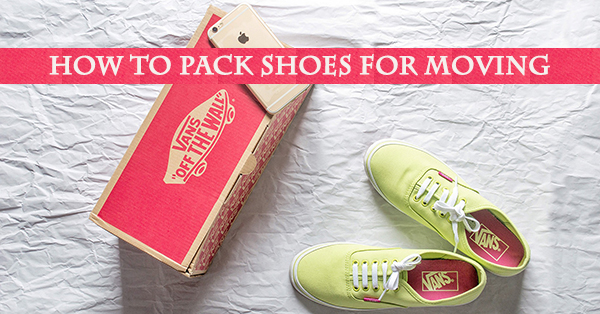




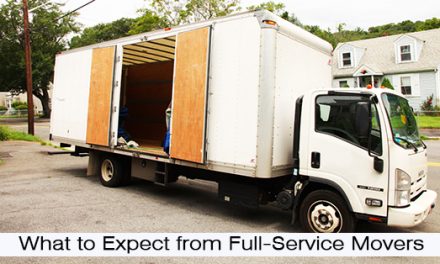

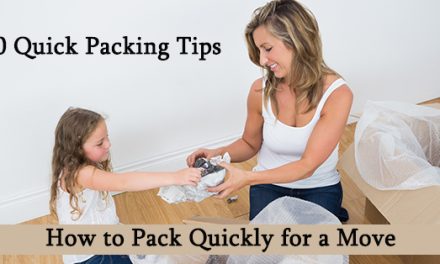

Fill the shoes with socks to save space and to avoid the shoes from crumpling.
It is rare in my professional life as mover to see any article that talks about packing tips of shoes while your move. Very nice and smart tips on tips.
I found this at the perfect time! I’m moving in a month and I had no idea how to pack my shoes. I really have a lot!